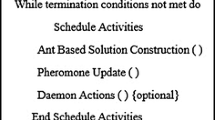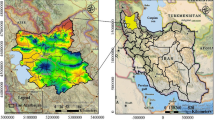Abstract
Beach realignment is caused by sediment movement across and along the beach due to the ever-changing incident waves. Its driving mechanisms are highly nonlinear and cannot be easily resolved by numerical process-response modeling which may also involve high computational costs. In this contribution, an alternative approach is developed to cope with the nonlinearity of beach realignment, which utilizes a neuro-fuzzy neural network optimized by a novel backtracking search algorithm. The network comprises multiple layers operating in sequence and establishes input–output relationships in terms of first-order fuzzy rules. The proposed backtracking search algorithm improves its performance by effectively modifying the existing mutation and crossover operations of the standard algorithm. A novel experimental setup was deployed in a touristic beach of Santorini island, Greece, to collect high frequency morphological and hydrodynamic information and generate a data set described by few representative input variables. Three additional networks were designed using the same data set. Standard criteria and nonparametric statistical analysis showed that the proposed approach outperforms all other tested methods in the case of modeling beach realignment, achieving also a significant improvement over previous efforts.








Similar content being viewed by others
References
Allenbach K, Garonna I, Herold C, Monioudi I, Giuliani G, Lehmann AF, Velegrakis AF (2015) Black Sea beach vulnerability to sea level rise. Environ Sci Policy 46:95–109
Armstrong JS (1985) Long-range forecasting: from crystal ball to computer, 2nd edn. Wiley, Hoboken
Atkinson AL, Power HE, Moura T, Hammond T, Callaghan DP, Baldock TE (2017) Assessment of runup predictions by empirical models on non-truncated beaches on the south-east Australian coast. Coast Eng 119:15–31
Briganti R, Bellotti G, Franco L, De Rouck J, Geeraerts J (2005) Field measurements of wave overtopping at the rubble mound breakwater of Rome-Ostia yacht harbour. Coast Eng 52(12):1155–1174
Chatterjee S, Nigam S, Roy A (2016) Software fault prediction using neuro-fuzzy network and evolutionary learning approach. Neural Comput Appl. https://doi.org/10.1007/s00521-016-2437-y
Chen CH, Lin CJ, Lin CT (2008) A functional-link-based neurofuzzy network for nonlinear system control. IEEE Trans Fuzzy Syst 16(5):1362–1378
Chen D, Lu R, Zou F, Li S, Wang P (2017) A learning and niching based backtracking search optimization algorithm and its applications in global optimization and ANN training. Neurocomputing 266:579–594
Chen C, Wang FW (2013) A self-organizing neuro-fuzzy network based on first order effects sensitivity analysis. Neurocomputing 118:21–32
Chen D, Zou F, Lu R, Wang P (2017) Learning backtracking search optimization algorithm and its application. Inf Sci 376:71–94
Civicioglu P (2013) Backtracking search optimization algorithm for numerical optimization problems. Appl Math Comput 219:8121–8144
Clerc M, Kennedy J (2002) The particle swarm-explosion, stability, and convergence in a multidimensional complex space. IEEE Trans Evol Comput 6(1):58–73
Dean RG (2002) Beach nourishment: theory and practice. advanced series on ocean engineering. World Scientific Publishing Company, Singapore
Gong W, Cai Z (2013) Differential evolution with ranking-based mutation operators. IEEE Trans Cybern 43(6):2066–2081
Gong W, Cai Z, Liang D (2015) Adaptive ranking mutation operator based differential evolution for constrained optimization. IEEE Trans Cybern 45(4):716–727
Han MF, Lin CT, Chang JY (2013) Differential evolution with local information for neuro-fuzzy systems optimization. Knowl Based Syst 44:78–89
Harley MD, Turner IL, Short AD (2015) New insights into embayed beach rotation: the importance of wave exposure and cross-shore processes. J Geophys Res 120:1470–1484
Hashemi MR, Ghadampour Z, Neill SP (2010) Using an artificial neural network to model seasonal changes in beach profiles. Ocean Eng 37:1345–1356
Hasiotis T, Velegrakis AF, Trygonis V, Topouzelis K, Andreadis O, Chatzipavlis A, Psarros F, Manoutsoglou E, Monioudi I (2017) Monitoring erosion risk in Kamari beach (Santorini). In: Proceedings of the CEST international conference 2017
Hinkel J, Nicholls RJ, Tol RSJ, Wang ZB, Hamilton JM, Boot G, Vafeidis AT, McFadden L, Ganopolski A, Klein RJT (2013) A global analysis of erosion of sandy beaches and sea-level rise: an application of DIVA. Global Planet Change 111:150–158
Hoeke RK, McInnes KL, Kruger JC, McNaught RJ, Hunter JR, Smithers SG (2013) Widespread inundation of Pacific islands triggered by distant-source wind-waves. Global Planet Change 108:128–138
Hsu CY, Lin SF, Chang JW (2013) Data mining–based hierarchical cooperative coevolutionary algorithm for TSK-type neuro-fuzzy networks design. Neural Comput Appl 23:485–498
Jiménez JA, Bosom E, Valdemoro HI, Guillén J (2012) Storm induced damages along the Catalan coast (NW Mediterranean) during the period 1958–2008. Geomorphology 143–144:24–33
Kennedy J, Eberhart RC (2001) Swarm intelligence. Morgan Kaufmann, Berlin
Kerh T, Lu H, Saunders R (2014) Shoreline change estimation from survey image coordinates and neural network approximation. Int J Civ Environ Struct Constr Archit Eng 8(4):381–386
Klein AHF, Benedet FL, Schumacher DH (2002) Seasonal-term beach rotation processes in distinct headland bay systems. J Coast Res 18(3):442–458
Komar PD (1998) Beach processes and sedimentation. Prentice Hall, Upper Saddle River
Li RP, Mukaidono M, Turksen IV (2002) A fuzzy neural network for pattern classification and feature selection. Fuzzy Sets Syst 130:101–108
Lin J (2015) Oppositional backtracking search optimization algorithm for parameter identification of hyperchaotic systems. Nonlinear Dyn 80:209–219
Mentaschi L, Vousdoukas MI, Voukouvalas E, Dosio A, Feyen L (2017) Global changes of extreme coastal wave energy fluxes triggered by intensified teleconnection patterns. Geo-phys Res Lett. https://doi.org/10.1002/2016gl072488
Monioudi IN, Velegrakis AF, Chatzipavlis AE, Rigos A, Karambas T, Vousdoukas MI, Hasiotis T, Koukourouvli N, Peduzzi P, Manoutsoglou E, Poulos SE, Collins MB (2017) Assessment of island beach erosion due to sea level rise: the case of the Aegean Archipelago (Eastern Mediterranean). Nat Hazards Earth Syst Sci 17:449–466
Neumann B, Vafeidis AT, Zimmerman J, Nicholls RJ (2015) Future coastal population growth and exposure to sea-level rise and coastal flooding—a global assessment. PLoS ONE. https://doi.org/10.1371/journal.pone.0118571
Pannu HS, Singh D, Malhi AK (2017) Multi-objective particle swarm optimization-based adaptive neuro-fuzzy inference system for benzene monitoring. Neural Comput Appl. https://doi.org/10.1007/s00521-017-3181-7
Plant NG, Aarninkhof SGJ, Turner IL, Kingston KS (2007) The performance of shoreline detection models applied to video imagery. J Coast Res 23(3):658–670
Price KV, Storn RM, Lampinen JA (2005) Differential evolution: a practical approach to global optimization. Springer, Berlin
Ranasinghe R, McLoughlan R, Seasonal A, Symonds G (2004) The southern oscillation index, wave climate and beach rotation. Mar Geol 204(3–4):273–287
Rigos A, Tsekouras GE, Chatzipavlis A, Velegrakis AF (2016) Modeling beach rotation using a novel Legendre polynomial feed forward neural network trained by nonlinear constrained optimization. IFIP Adv Inf Commun Technol 475:167–179
Rigos A, Tsekouras GE, Vousdoukas MI, Chatzipavlis A, Velegrakis AF (2016) A Chebyshev polynomial radial basis function neural network for automated shoreline extraction from coastal imagery. Integr Comput Aided Eng 23:141–160
Roelvink D, Reneirs A, van Dongeren A, van Thiel de Vries J, Lescinsky J, McCall R (2009) Modeling storm impacts on beaches, dunes and barrier islands. Coast Eng 56:1133–1152
Ruggiero P, Holman RA, Beach RA (2004) Wave run-up on a high energy dissipative beach. J Geophys Res 109(C06025):1–12
Short AD, Jackson DWT (2013) Beach morphodynamics. In: Shroder John F (ed) Treatise on geomorphology. Academic Press, Cambridge, pp 106–129
Short AD, Trembanis AC (2004) Decadal scale patterns of beach oscillation and rotation: Narabeen beach, Australia, time series PCA and wavelet analysis. J Coast Res 20(2):523–532
Song X, Zhang X, Zhao S, Li L (2015) Backtracking search algorithm for effective and efficient surface wave analysis. J Appl Geophys 114:19–31
Stockdon HF, Holman RA, Howd PA, Sallenger JAH (2006) Empirical parameterization of setup, swash, and runup. Coast Eng 53(7):573–588
Storn R, Price K (1997) Differential evolution- a simple and efficient heuristic for global optimization over continuous spaces. J Global Optim 11(4):341–359
Thomas T, Phillips MR, Williams AT, Jenkins RE (2011) Decadal timescale beach rotation: gale climate and offshore island influences. Geomorphology 135:97–107
Thomas T, Phillips MR, Williams AT (2013) A centurial record of beach rotation. J Coast Res 65:594–599
Thomas T, Rangel-Buitrago N, Phillips MR, Anfuso G, Williams AT (2015) Mesoscale morphological change, beach rotation and storm climate influences along a macrotidal embayed beach. J Mar Sci Eng 3:1006–1026
Tikhonov AN, Goncharsky AV, Stepanov VV, Yagola AG (1995) Numerical methods for the solution of ill-posed problems. Kluwer Academic Publisher, Dordrecht
Tofallis C (2015) A better measure of relative prediction accuracy for model selection and model estimation. J Oper Res Soc 66(8):1352–1362
Tsekouras GE, Trygonis V, Maniatopoulos A, Rigos A, Chatzipavlis A, Tsimikas J, Mitianoudis N, Velegrakis AF (2017) A Hermite neural network incorporating artificial bee colony optimization to model shoreline realignment at a reef-fronted beach. Neurocomputing 280:32–45
Tsekouras GE, Trygonis V, Rigos A, Chatzipavlis A, Tsolakis D, Velegrakis AF (2017) Neuro-fuzzy network for modeling the shoreline realignment of the Kamari beach, Santorini, Greece. Commun Comput Inf Sci 744:229–241
Tsolakis D, Tsekouras GE, Tsimikas J (2012) Fuzzy vector quantization for image compression based on competitive agglomeration and a novel codeword migration strategy. Eng Appl Artif Intell 25(6):1212–1225
Velegrakis AF, Vousdoukas M, Andreadis O, Pasakalidou E, Adamakis G, Meligonitis R (2008) Influence of dams on downstream beaches: Eressos, Lesbos, Eastern Mediterranean. Mar Georesour Geotechnol 26:350–371
Velegrakis AF, Trygonis V, Chatzipavlis AE, Karambas T, Vousdoukas MI, Ghionis G, Monioudi IN, Hasiotis T, Andreadis O, Psarros F (2016) Shoreline variability of an urban beach fronted by a beachrock reef from video imagery. Nat Hazards 83(1):201–222
Vousdoukas MI, Velegrakis AF, Dimou K, Zervakis V, Conley DC (2009) Wave run-up observations in microtidal, sediment-starved beaches of the Eastern Mediterranean. J Mar Syst 78:537–547
Vousdoukas MI, Ferreira PM, Almeida LP, Dodet G, Psaros F, Andriolo U, Taborda R, Silva AN, Ruano A, Ferreira OM (2011) Performance of intertidal topography video monitoring of a meso-tidal reflective beach in South Portugal. Ocean Dyn 61(10):1521–1540
Vousdoukas MI, Mentaschi L, Voukouvalas E, Verlaan M, Feyen L (2017) Extreme sea levels on the rise along Europe’s coasts. Earth’s Future 5:304–323. https://doi.org/10.1002/2016EF000505
Zhao W, Wang L, Wang B, Yin Y (2016) Best guided backtracking search algorithm for numerical optimization problems. Lect Notes Artif Intell 9983:414–425
Zheng YJ, Ling HF, Chen SY, Xue JY (2015) A hybrid neuro-fuzzy network based on differential biogeography-based optimization for online population classification in earthquakes. IEEE Trans Fuzzy Syst 23(4):1070–1083
Acknowledgements
The authors would like to thank the anonymous reviewers for their effort to provide valuable comments on this paper.
Author information
Authors and Affiliations
Corresponding author
Ethics declarations
Conflict of interest
The authors declare that they have no conflict of interest.
Funding
This research was funded by the EEA GRANTS 2009–2014 and the Public Investments Program (PIP) of the Hellenic Republic (Project ERABEACH: ‘Recording of and Technical Responses to Coastal Erosion of Touristic Aegean island beaches’).
Rights and permissions
About this article
Cite this article
Chatzipavlis, A., Tsekouras, G.E., Trygonis, V. et al. Modeling beach realignment using a neuro-fuzzy network optimized by a novel backtracking search algorithm. Neural Comput & Applic 31, 1747–1763 (2019). https://doi.org/10.1007/s00521-018-3809-2
Received:
Accepted:
Published:
Issue Date:
DOI: https://doi.org/10.1007/s00521-018-3809-2




